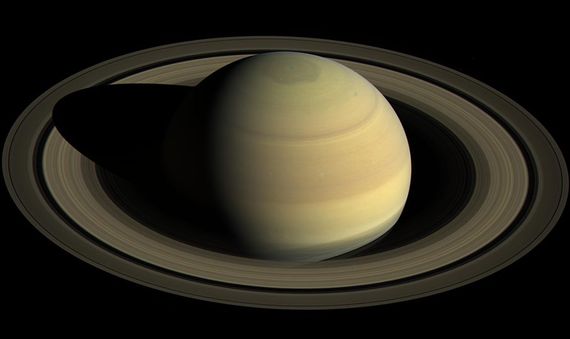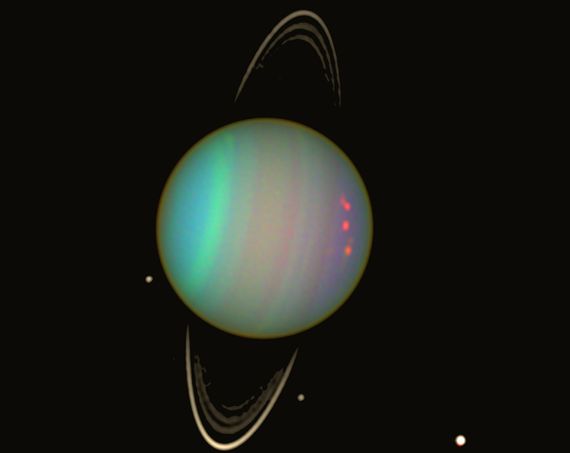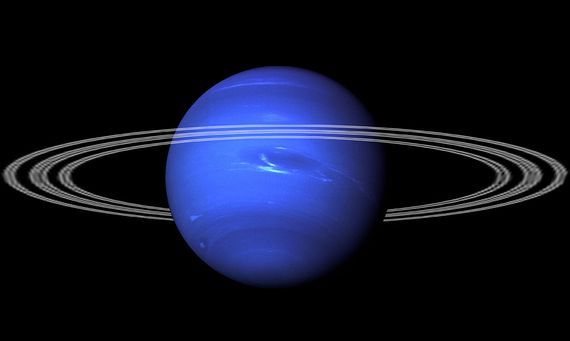Just like the Olympics, there are five planetary rings systems that we know about so far in our solar system. Saturn’s are the most visible and the most striking, but they are no longer the only ones after the chain of discoveries of the last four decades. On 10 March 1977, we detected the thirteen rings of Uranus, the planet with the most. Two years later, in 1979, we spotted those that surround the gas giant Jupiter. Then in 1989 we discovered the rings of the blue planet Neptune, and most recently, in 2013, we learned that the planetoid Chariklo, situated between Saturn and Uranus, has a double ring. Is our solar system hiding any more?
The “handles” of Saturn that Galileo first saw
The first person to spot the rings of Saturn was Galileo Galilei in 1610. To his surprise, that wandering star appeared to show a pair of “handles or arms,” although he couldn’t make them out clearly because of his rudimentary telescopes. Almost 50 years later, Dutch scientist Christiaan Huygens proved that these “handles” of Saturn were, in fact, a ring. After that, the descriptions of the mysterious ring continued unabated, although nobody knew what they were composed of.

Thanks to the images sent by the twin space probes Voyager 1 and 2 at the beginning of the 1980s, we discovered that the four rings of Saturn are mostly (more than 90%) composed of small particles of ice. The most accepted theory to explain the formation of these structures suggests that during the birth of the solar system some 4.6 billion years ago, a satellite collided with Saturn. The ring system is all that remains after that gigantic collision with an ice moon containing a rocky core.
The thirteen rings of Uranus
It would take us more than three and a half centuries from the time of Galileo’s observations to find other planetary rings, this time on the ice giant Uranus. In 1977 American astronomers James L. Elliot, Edward W. Dunham and Jessica Mink discovered the second most complex set of rings in the solar system. They are thirteen very dark rings that seem to be composed of particles of ice and dust.

In 1986 the Voyager 2 space probe sent the first close-up images of these rings, which are believed to be 600 million years old, which in astronomical time is very recent. They were likely created from the fragments shot out from multiple collisions of satellites with Uranus. Over time these remains struck one another, giving rise to numerous particles, which today make up these narrow rings.
The reddish rings of the gas giant Jupiter
The Voyager 1 probe took the first images of Jupiter’s rings 40 years ago, in 1979. They are not easily observed from Earth because incredibly powerful telescopes are required. The Voyager 2, Galileo, Cassini and New Horizons probes have all sent back images of the Jovian rings since the 1980s: they are weak and, in contrast to the ice particle rings of Saturn, are composed mostly of dust. This dust comes from some of the 79 satellites (as of 2019) orbiting Jupiter, which are called shepherd moons because of the agglutinating effect they exert on the herd of particles that form a planetary ring.

The rings of the largest planet in the solar system consist of four structures. From the innermost to the outermost part: a thick torus of particles called the halo ring; a bright but very narrow main ring; and two wide, thick, faint rings called the Amalthea gossamer ring and the Thebe gossamer ring (names of the satellites from which the ring material originates). The halo and the main ring contain dust expelled from the Metis and Adrastea shepherd moons.
Liberty, Equality and Fraternity on Neptune
The last of the planets of the solar system has very dark rings, ethereal and faint, which we discovered in 1989 thanks to the Voyager 2 probe. They are more similar to Jupiter’s rings than to those of Saturn or Uranus, and are mainly formed of dust coming from the shepherd moon Galatea.

Neptune —the bluest planet in the solar system— has five rings that are named after the most relevant astronomers that have investigated the planet. They are, from the innermost to the outermost: Galle, Le Verrier, Lassell, Arago and Adams. The Adams ring includes five bright areas called Fraternity, Equality 1, Equality 2, Liberty and Courage —in reference to the French Revolution, since they were discovered during its bicentennial. These zones correspond to places where the dust particles are more compacted.
The double surprise of the minor planet Chariklo

It’s not just the four gaseous planets of the solar system that have rings: the Chariklo minor planet, situated between Saturn and Uranus, is also ringed, and doubly so. It wasn’t until 2013 that we discovered, by surprise, that this object had two narrow and dense rings, whose origin is still unknown. Chariklo is the smallest celestial object that has these structures, in its case two narrow bands only three and seven kilometres wide, nicknamed Oiapoque and Chuí, which are separated by a gap of nine kilometres.
At 250 kilometres in diameter, Chariklo is the largest planetoid of the so-called centaurs, which orbit the Sun between Saturn and Uranus in the outer Solar System. Centaurs can behave like asteroids or comets, hence their name, since in Greek mythology a centaur is a mythological being that is half horse and half human. Perhaps some of these peculiar objects hide new and extraordinary astronomical discoveries.
Comments on this publication